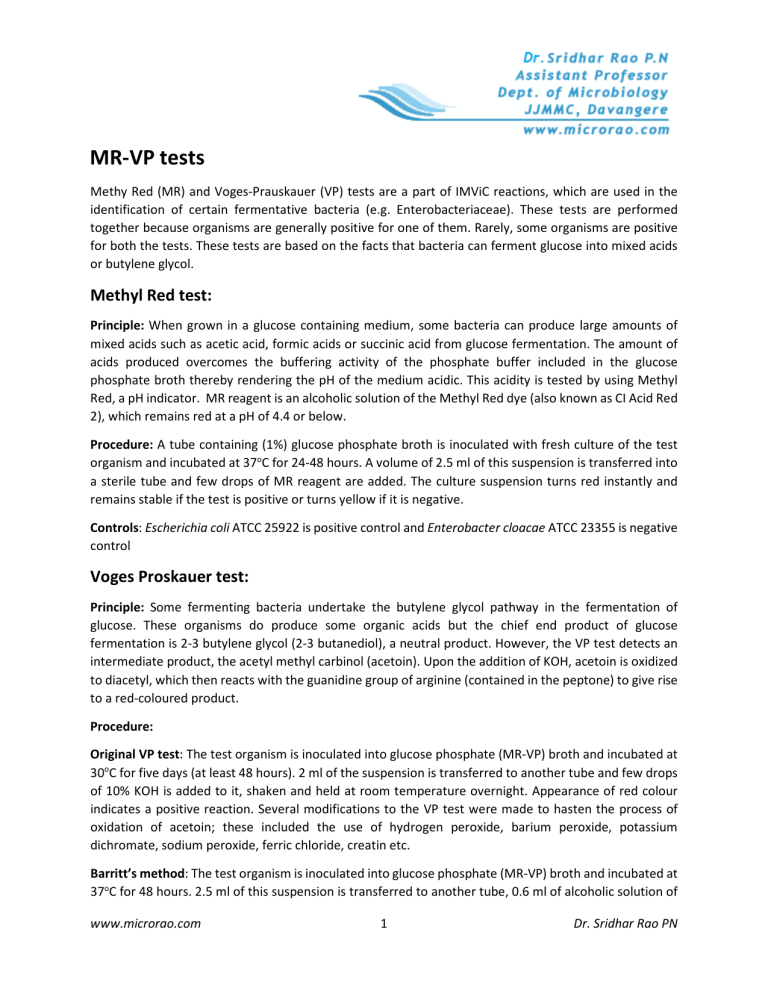
MR-VP tests Methy Red (MR) and Voges-Prauskauer (VP) tests are a part of IMViC reactions, which are used in the identification of certain fermentative bacteria (e.g. Enterobacteriaceae). These tests are performed together because organisms are generally positive for one of them. Rarely, some organisms are positive for both the tests. These tests are based on the facts that bacteria can ferment glucose into mixed acids or butylene glycol. Methyl Red test: Principle: When grown in a glucose containing medium, some bacteria can produce large amounts of mixed acids such as acetic acid, formic acids or succinic acid from glucose fermentation. The amount of acids produced overcomes the buffering activity of the phosphate buffer included in the glucose phosphate broth thereby rendering the pH of the medium acidic. This acidity is tested by using Methyl Red, a pH indicator. MR reagent is an alcoholic solution of the Methyl Red dye (also known as CI Acid Red 2), which remains red at a pH of 4.4 or below. Procedure: A tube containing (1%) glucose phosphate broth is inoculated with fresh culture of the test organism and incubated at 37oC for 24-48 hours. A volume of 2.5 ml of this suspension is transferred into a sterile tube and few drops of MR reagent are added. The culture suspension turns red instantly and remains stable if the test is positive or turns yellow if it is negative. Controls: Escherichia coli ATCC 25922 is positive control and Enterobacter cloacae ATCC 23355 is negative control Voges Proskauer test: Principle: Some fermenting bacteria undertake the butylene glycol pathway in the fermentation of glucose. These organisms do produce some organic acids but the chief end product of glucose fermentation is 2-3 butylene glycol (2-3 butanediol), a neutral product. However, the VP test detects an intermediate product, the acetyl methyl carbinol (acetoin). Upon the addition of KOH, acetoin is oxidized to diacetyl, which then reacts with the guanidine group of arginine (contained in the peptone) to give rise to a red-coloured product. Procedure: Original VP test: The test organism is inoculated into glucose phosphate (MR-VP) broth and incubated at 30oC for five days (at least 48 hours). 2 ml of the suspension is transferred to another tube and few drops of 10% KOH is added to it, shaken and held at room temperature overnight. Appearance of red colour indicates a positive reaction. Several modifications to the VP test were made to hasten the process of oxidation of acetoin; these included the use of hydrogen peroxide, barium peroxide, potassium dichromate, sodium peroxide, ferric chloride, creatin etc. Barritt’s method: The test organism is inoculated into glucose phosphate (MR-VP) broth and incubated at 37oC for 48 hours. 2.5 ml of this suspension is transferred to another tube, 0.6 ml of alcoholic solution of www.microrao.com 1 Dr. Sridhar Rao PN α-naphthol is added and shaken. To this, 0.2 ml of 40% KOH is added, the tube is shaken and let to stand at room temperature for 15 minutes. Appearance of red colour indicates positive test. If negative, the tube must be held for another 45 minutes. In this test, α-naphthol serves as a catalyst and a colour intensifier. Since the use of α-naphthol was recommended by Maxwell Barritt, this method is also known as Barritt’s method. O’Meara’s method: The test organism is inoculated into glucose phosphate (MR-VP) broth and incubated at 37oC for 48 hours. 2.5 ml of this suspension is transferred to another tube and 0.6 ml of O’Meara’s reagent (40% KOH + 0.3% creatine) is added. The tube is placed in a water bath at 37oC for 4 hours with intermittent shaking for aeration. Appearance of red colour is a positive reaction. O’Meara’s reagent has been reported to be unstable. Quicker VP tests: The results of VP test can be obtained earlier by heavily inoculating a 0.5-1 ml volume of glucose phosphate broth and incubating at 37oC for 18-24 hours. This method was suggested by Benjaminson et al. Barry’s rapid direct VP test: This test is performed on lactose-fermenting colonies (on MacConkey’s agar or TSI agar slant). These colonies contain detectable amounts of acetoin from the fermentation of sugars. Two drops of 0.5% creatine solution is taken in a tube and colonies are emulsified densely into it. To this, three drops of 5% α-naphthol (in 95% ethyl alcohol) is added and shaken. Next, two drops of 40% KOH is added and shaken. Appearance of pink-red colour in 15 minutes is a positive reaction. Barry’s rapid indirect VP test: 0.2 ml of MR-VP broth is inoculated with a single colony of the test organism and incubated at 37oC for 4-6 hours. To this, two drops of 0.5% creatine solution is added and shaken. This is followed by addition of three drops of α-naphthol and two drops of 40% KOH and shaken. Appearance of pink-red colour in 15 minutes is a positive reaction. Controls: Enterobacter cloacae ATCC 23355 is positive control and Escherichia coli ATCC 25922 is negative control Examples: • • • Among Enterobacteriaceae members, Escherichia sps, Salmonella sps, Shigella sps, Providencia sps, Morganella sps, Citrobacter sps, Edwardsiella sps are MR test positive. Enterobacter sps, Klebsiella sps and Serratia sps are generally VP test positive and MR test negative. However, members of Serratia exhibit variations; some species are positive for MR, VP or both the tests. Proteus myxofaciens, Enterobacter intermedium, Klebsiella planticola and Serratia liquefaciens are both MR and VP tests positive. Some strains of P. mirabilis are VP test positive. Few species of Vibrio (ElTor variety of V. cholerae, V. anguillarum, V.costicola & V. damsela) are VP test positive. Few Gram positive cocci are also VP test positive. These include species of Staphylococcus (S. aureus, S. epidermidis, S. intermedius, S. saprophyticus), Micrococcus (M. kristinae, M. luteus), Streptococcus (S. pyogenes, S. agalactiae, S. mutans) and Enterococcus (E. fecalis). Limitations or MR VP tests: Since these tests (especially VP test) require prolonged incubation, they are not very helpful in identification of isolates in routine diagnostic setup. Acetoin could be further degraded (reduced to butylene glycol or oxidized to diacetyl) by the isolate, thereby giving false negative reactions. www.microrao.com 2 Dr. Sridhar Rao PN





